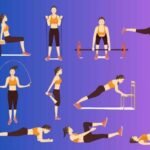10 Easy Home Workouts for Busy People: Get Fit Without Leaving the House : In today’s hectic world, finding time for exercise can feel like an impossible task. But staying active is essential for maintaining physical and mental well-being. The good news is that you don’t need a gym membership or hours of free time to stay fit. Home workouts are a practical, time-efficient solution that can fit into any schedule, no matter how busy you are.
Here’s a detailed guide to
10 easy home workouts that require little to no equipment, can be done in 10-30 minutes, and are perfect for people on the go
1. Bodyweight Squats
Muscles worked: Quads, hamstrings, glutes, core
Why it works: Squats are a powerful compound movement that strengthens your entire lower body and core. They help build muscle, burn calories, and improve mobility.
How to Do It:
- Stand with your feet shoulder-width apart, toes slightly turned out.
- Keep your chest up, core engaged, and bend your knees to lower your body as if sitting in a chair.
- Lower until your thighs are parallel to the floor, then push through your heels to stand back up.
Tips:
- Perform 3 sets of 15-20 reps.
- Add a jump at the end for a more intense cardio burst.
2. Push-Ups
Muscles worked: Chest, shoulders, triceps, core
Why it works: Push-ups target your upper body and core, improving strength, endurance, and stability.
How to Do It:
- Start in a high plank position with your hands slightly wider than shoulder-width apart.
- Lower your body until your chest is just above the floor, keeping your elbows at a 45-degree angle.
- Push back up to the starting position while keeping your core tight and body straight.
Tips:
- Modify by doing knee push-ups if you’re a beginner.
- Aim for 3 sets of 10-15 reps.
3. Plank
Muscles worked: Core, shoulders, back
Why it works: Planks are an excellent exercise for core strength, stability, and posture improvement. They engage multiple muscle groups without requiring movement.
How to Do It:
- Start in a forearm plank position, with elbows directly under your shoulders and body forming a straight line from head to heels.
- Engage your core, squeeze your glutes, and hold the position for 30-60 seconds.
Tips:
- If you need to modify, drop your knees to the ground.
- Challenge yourself by holding the plank for longer each time or adding side planks.
4. Lunges
Muscles worked: Quads, hamstrings, glutes, core
Why it works: Lunges are fantastic for building leg strength, improving balance, and targeting each leg independently.
How to Do It:
- Stand tall and take a big step forward with your right foot.
- Lower your hips until both knees are bent at 90 degrees, making sure your front knee doesn’t extend past your toes.
- Push through your right heel to return to standing and repeat on the left leg.
Tips:
- Perform 3 sets of 10-12 reps per leg.
- Add a dumbbell or water bottle in each hand for extra resistance.
5. Glute Bridges
Muscles worked: Glutes, hamstrings, lower back
Why it works: This simple but effective move strengthens the glutes and core, helping to improve posture and alleviate lower back pain.
How to Do It:
- Lie on your back with your knees bent and feet flat on the floor, hip-width apart.
- Push through your heels to lift your hips off the floor, squeezing your glutes at the top.
- Lower your hips back to the floor and repeat.
Tips:
- Perform 3 sets of 15-20 reps.
- Add intensity by holding a weight on your hips or performing single-leg glute bridges.
6. Jumping Jacks
Muscles worked: Full body (legs, core, arms)
Why it works: Jumping jacks are a classic cardiovascular exercise that gets your heart rate up, helping you burn calories and improve endurance.
How to Do It:
- Stand with your feet together and arms at your sides.
- Jump your feet out while raising your arms overhead, then jump back to the starting position.
Tips:
- Do jumping jacks for 30-60 seconds to boost your heart rate.
- Incorporate into a circuit workout for a cardio interval.
7. Tricep Dips
Muscles worked: Triceps, shoulders, chest
Why it works: Tricep dips target the often-neglected back of your arms, helping to tone and strengthen your triceps and shoulders.
How to Do It:
- Sit on the edge of a chair or bench with your hands gripping the edge.
- Slide your hips off the seat and lower your body until your elbows are bent at 90 degrees.
- Push yourself back up by straightening your arms.
Tips:
- Perform 3 sets of 10-15 reps.
- To make it harder, straighten your legs or elevate your feet.
8. Mountain Climbers
Muscles worked: Core, shoulders, legs
Why it works: Mountain climbers are a dynamic full-body exercise that raises your heart rate while toning your core, legs, and upper body.
How to Do It:
- Start in a high plank position.
- Quickly drive your right knee toward your chest, then switch legs, bringing the left knee toward your chest in a running motion.
- Keep your core tight and hips level as you alternate legs as fast as possible.
Tips:
- Perform for 30-60 seconds.
- Maintain a consistent rhythm to maximize the cardio effect.
9. High Knees
Muscles worked: Legs, core
Why it works: High knees are a great cardio move that also strengthens your legs and core.
How to Do It:
- Stand tall and quickly lift one knee up toward your chest while swinging the opposite arm.
- Alternate legs as fast as possible, keeping your core engaged and maintaining an upright posture.
Tips:
- Perform high knees for 30-60 seconds for a quick cardio boost.
- Incorporate into a circuit for high-intensity intervals.
10. Wall Sits
Muscles worked: Quads, hamstrings, glutes, core
Why it works: Wall sits are a static exercise that builds strength and endurance in the lower body, especially the thighs.
How to Do It:
- Stand with your back against a wall and slide down into a seated position, with your thighs parallel to the floor and knees bent at 90 degrees.
- Hold the position as long as you can, aiming for 30-60 seconds.
Tips:
- Perform 3 sets of 30-60 seconds.
- Add intensity by holding weights or lifting one leg at a time.
How to Fit Home Workouts into a Busy Schedule
Here are a few strategies to make sure you stay consistent, even with a packed schedule:
A. Plan Ahead
- Schedule your workouts like any other appointment. Block out 10-30 minutes each day for physical activity.
B. Break It Up
- If you don’t have time for a full workout, split it into shorter sessions. Do 5-10 minutes in the morning, afternoon, and evening.
C. Create a Routine
- Build your workout into your daily routine. You can do squats while brushing your teeth, lunges during TV commercials, or push-ups during breaks at work.
D. Focus on Consistency Over Intensity
- Don’t worry about doing long, intense workouts. Short, consistent exercise sessions will deliver significant benefits over time.
Conclusion
These 10 home workouts are designed for busy people who want to stay fit without spending hours at the gym. By incorporating bodyweight exercises like squats, push-ups, lunges, and planks, along with cardio moves like jumping jacks and mountain climbers, you can get a full-body workout in the comfort of your home. Whether you have 10 minutes or 30 minutes, these exercises will help you stay in shape, improve your strength, and boost your overall health. Remember, the key is consistency—just a few minutes of exercise each day can make a huge difference in your fitness and well-being.
Introduction to Home Workouts
In today’s fast-paced world, finding time for regular physical exercise can often feel like a challenging task. With busy work schedules, family commitments, and a myriad of daily responsibilities, many individuals struggle with maintaining a consistent workout regimen. Home workouts emerge as a valuable solution, enabling busy people to incorporate fitness into their lives without the need for extensive travel or time commitments associated with gym visits.
Home workouts can be defined as exercise routines conducted in the comfort of one’s own living space. These workouts provide the flexibility needed to accommodate the unpredictable nature of modern life, allowing individuals to take charge of their fitness journey. The significance of this approach lies not only in the convenience it offers but also in its potential to foster a healthier lifestyle without overwhelming schedules.
Common barriers to exercising regularly often include time constraints, lack of motivation, and feelings of intimidation in a gym environment. However, home workouts address these challenges head-on. They eliminate the commute to a fitness facility, allowing individuals to exercise at their convenience. Additionally, the comfort of being at home can alleviate anxiety associated with working out in public spaces, thus encouraging consistent engagement with fitness routines.
The following sections will outline ten easy home workouts tailored specifically for busy individuals. These routines are designed to optimize efficiency, ensuring that even the most hectic schedules can accommodate a commitment to better health. By integrating these workouts into daily life, individuals can not only improve their physical fitness but also enhance mental well-being, fostering a balanced lifestyle amidst the hustle and bustle of everyday responsibilities.
Benefits of Working Out at Home
Exercising at home presents numerous advantages that cater specifically to the needs of busy individuals. One of the most significant benefits is convenience. Home workouts eliminate the time and effort spent commuting to a gym, allowing individuals to integrate physical activity seamlessly into their daily schedules. This not only saves time but also makes it easier to remain consistent in one’s fitness routine, as workouts can be performed at any time that fits the individual’s lifestyle, whether it’s early in the morning or late at night.
Another notable advantage of exercising at home is cost-effectiveness. Gym memberships often come with monthly fees that can add up over time. By opting for home workouts, individuals can bypass these costs, as they can utilize bodyweight exercises or invest in minimal equipment that suits their budget. This approach to fitness can be particularly beneficial for those looking to maintain their health without incurring significant financial burdens.
Furthermore, working out at home provides a unique opportunity to create a personalized workout environment tailored to individual preferences. This allows for complete control over factors such as music, lighting, and even workout attire, fostering an atmosphere that encourages motivation and enjoyment. The comfort of one’s own space can also significantly reduce feelings of intimidation that may arise in a traditional gym setting, especially for beginners or those who may feel self-conscious about their fitness levels.
Ultimately, exercising at home supports the development of consistency and confidence, catering to busy lifestyles while promoting a sustainable approach to health and fitness. In this way, home workouts not only serve as a practical alternative to gym sessions but also enhance one’s overall workout experience.
Getting Started: Essentials for Home Workouts
Embarking on a home workout journey can be a seamless process when you equip yourself with the necessary tools and mental preparation. First and foremost, having the right equipment is essential to maximize the effectiveness of your workouts. Basic yet versatile items, such as resistance bands, dumbbells, and a yoga mat, will allow you to perform a wide range of exercises that accommodate various fitness levels and goals.
Resistance bands are particularly valuable for strength training, offering the ability to increase or decrease tension according to your capability. They are lightweight and easy to store, making them suitable for home use. Dumbbells, whether adjustable or fixed weight, can enhance your strength training regimen and are fundamental for building muscle mass and endurance.
A yoga mat serves dual purposes; it offers a comfortable surface for floor exercises and provides grip during stretching routines. Beyond these essential items, ensuring a dedicated workout space is vital for fostering a workout routine. Select a quiet area in your home with ample room to move freely, ideally away from distractions like television or excessive noise. Organizing your space can significantly impact your motivation, so keeping it tidy and stocked with your fitness essentials is advisable.
Moreover, consider setting a schedule that integrates your home workouts into your daily routine. This might involve choosing specific times to exercise, making it easier to cultivate the habit. Finally, mentally preparing for your workouts can enhance your commitment; establishing goals—whether they be related to fitness, stamina, or mental well-being—can provide additional motivation and clarity. By gathering the right equipment and preparing your space, you are setting the foundation for an effective and sustainable home workout routine.
Workout 1: Quick Bodyweight Circuit
For individuals seeking efficient exercise solutions, a quick bodyweight circuit presents an excellent option. This workout can be completed in a mere 10 to 15 minutes, making it ideal for busy schedules while also providing an effective way to enhance overall fitness. The circuit comprises three foundational exercises: squats, push-ups, and jumping jacks, which collectively target multiple muscle groups and promote cardiovascular fitness.
To initiate the circuit, begin with a set of 10-15 squats. Squats are essential for strengthening the lower body and enhancing core stability. It is imperative to maintain proper form; ensure your back is straight and knees do not extend beyond your toes during the movement. For those requiring a modification, chair squats can provide additional support.
Next, transition to push-ups. Aim for 8-12 repetitions to effectively work the chest, shoulders, and triceps. If traditional push-ups are too challenging, consider performing them on your knees or using an elevated surface such as a bench. This modification maintains the benefits while accommodating varying fitness levels.
Lastly, incorporate jumping jacks for 30 seconds to 1 minute. This exercise elevates the heart rate and aids in increasing aerobic capacity. To modify this exercise, opt for low-impact jacks by stepping side to side while raising your arms, which still promotes aerobic benefits without the higher impact.
To maximize efficiency, perform each exercise in succession with minimal rest in between. Repeat the circuit two to three times to achieve a comprehensive workout in a condensed time frame. By implementing this quick bodyweight circuit, busy individuals can effectively incorporate physical activity into their daily routine without the need for specialized equipment or extensive time commitment.
High-Intensity Interval Training (HIIT)
High-Intensity Interval Training (HIIT) is a popular workout method that maximizes results in a minimal amount of time, making it an ideal choice for busy individuals. This exercise regimen alternates between short bursts of intense exercise and brief periods of rest or lower-intensity activity. As a consequence, HIIT not only helps enhance cardiovascular fitness but also boosts metabolic rate for several hours post-workout, which can be particularly beneficial for those with tight schedules.
A typical HIIT session may last anywhere from 15 to 30 minutes, yet it can effectively engage multiple muscle groups. For instance, a structured HIIT workout could include exercises such as burpees, mountain climbers, jump squats, and high knees. Conducting these movements in a circuit format, with 20-30 seconds of high intensity followed by a short 10-15 seconds of rest, allows participants to maximize their effort and achieve significant health benefits without a hefty time investment.
Beyond the physical benefits, HIIT workouts also possess psychological advantages, as they can be completed relatively quickly, which may reduce the mental barrier to exercising regularly. The variety of exercises not only fights workout monotony but also keeps participants engaged, making it a more enjoyable experience. Furthermore, HIIT can be easily modified to cater to various fitness levels, ensuring that everyone from a beginner to a seasoned athlete can participate and gain from its effects. Overall, the efficiency and adaptability of HIIT workouts make them a superb option for anyone seeking to incorporate a time-effective fitness strategy into their busy lives.
Workout 3: Yoga or Stretching Routine
Incorporating a yoga or stretching routine into a busy lifestyle can significantly improve overall flexibility, help in stress relief, and enhance mobility. Finding just 10-15 minutes throughout your day for a brief session can have profound benefits, particularly for individuals with demanding schedules. Stretching not only promotes physical well-being, but it also aids in mental relaxation, making it an invaluable addition to your workout regimen.
One effective approach is to begin your routine with a simple warm-up. Consider starting with neck rolls and shoulder shrugs, which can alleviate tension from sitting at a desk or engaging in repetitive activities. Following this, you can transition into poses that emphasize lengthening the spine and stretching major muscle groups. The Cat-Cow stretch is a great way to wake up the back and enhance flexibility in the spine. Begin on all fours and alternate between arching your back upwards and dipping it down, engaging your core throughout.
Next, you might want to incorporate the Downward Facing Dog pose. This position stretches the hamstrings, calves, and shoulders while also allowing the body to decompress. Maintain this pose for a few deep breaths, feeling the stretch deepen each time you exhale. Additionally, the Seated Forward Bend can be performed to target the lower back and hamstrings—an excellent way to conclude your routine. Simply sit with your legs extended and reach toward your toes, limiting strain by keeping your knees slightly bent if necessary.
Incorporating these yoga poses and stretches into your day offers a productive way to combat stress and improve mobility. Whether taken as a break during work or as a way to unwind before bed, a dedicated yoga or stretching routine is achievable, even for the busiest individuals. Prioritizing these moments can lead to significant enhancements in your physical and mental well-being, making it a practical choice for everyone.
Workout 4: Tabata Training
Tabata training is a high-intensity interval training (HIIT) protocol that has gained popularity due to its efficiency and effectiveness in burning calories and improving physical fitness in a short amount of time. This training method involves alternating between short bursts of intense exercise followed by brief rest intervals, typically structured as 20 seconds of all-out effort followed by 10 seconds of rest. This cycle is repeated for a total of four minutes, making it a highly time-efficient workout ideal for busy individuals.
One of the primary advantages of Tabata training is its flexibility. It can be applied to a variety of exercises, allowing participants to tailor workouts according to their fitness levels and preferences. For instance, common exercises used in Tabata routines include burpees, push-ups, squats, and jumping jacks. With only a few minutes required for each round, busy individuals can incorporate Tabata into their schedules with ease, whether at home or in a gym setting.
To maximize the benefits of this workout, it is advisable to focus on techniques that work multiple muscle groups simultaneously. For example, a Tabata session may begin with burpees, followed by mountain climbers, then switch to lunges, and conclude with high knees. This variety not only keeps the workout engaging but also ensures a comprehensive approach to cardiovascular and strength training. Moreover, since the format allows for very short rest periods, the heart rate remains elevated, promoting improved cardiovascular health and endurance.
In conclusion, Tabata training exemplifies an efficient workout strategy for individuals with tightly packed schedules, enabling them to maintain their fitness levels despite time constraints. By adopting this simple yet effective protocol, busy people can incorporate physical activity into their daily lives without sacrificing essential commitments.
Workout 5: Dance or Cardio Routine
For individuals with demanding schedules, finding a workout that is both enjoyable and effective can be challenging. Incorporating a dance or cardio routine into your weekly exercise regimen can be a delightful solution that fits seamlessly into a busy lifestyle. Not only do these activities elevate your heart rate, fostering cardiovascular health, but they also offer a refreshing break from more traditional workout methods.
Many online platforms provide an array of dance and cardio classes that cater to different preferences and skill levels. Websites and applications such as YouTube, Fitness Blender, and Peloton offer an extensive selection of follow-along videos that can transform exercise into an engaging experience. From Zumba to hip-hop dance, the variety available allows individuals to choose routines that not only meet their fitness goals but also align with their interests.
The flexibility of these workouts ensures that they can be easily integrated into anyone’s day. A quick 20 to 30-minute session can be performed in the comfort of your living room or even outdoors, allowing for breaks from work or family obligations while participating in a fun, practical activity. Additionally, many resources provide guided sessions that encourage you to move at your own pace, making it accessible regardless of fitness level.
Finding the right rhythm through dance or engaging in high-energy cardio not only helps improve endurance and coordination but also serves as a great stress reliever. The upbeat nature of these workouts can elevate mood, making them an excellent choice for busy individuals looking to inject some joy into their fitness journey. Ultimately, through the integration of dance or cardio routines, the path to achieving personal health and fitness objectives becomes more enjoyable and sustainable.
Creating a Schedule for Consistency
Establishing a consistent workout schedule is essential for anyone looking to integrate exercise into a busy lifestyle. For many, finding the time to work out can feel daunting, leading to the abandonment of fitness goals. However, by implementing a structured plan, individuals can successfully prioritize their health without overwhelming themselves. One effective method is to block out specific time slots in personal calendars dedicated solely to workouts. Whether it’s early in the morning, during lunch breaks, or in the evening, allocating fixed times can create a sense of commitment. This practice not only carves out time for physical activity but also serves as a reminder that fitness is a valuable part of one’s daily routine.
Using reminders and alerts on smartphones can further bolster accountability. Setting daily or weekly notifications can prompt individuals to prepare for their scheduled workouts, thereby reinforcing the habit of exercising regularly. Additionally, visual cues can be beneficial. Placing workout gear in visible areas or creating a dedicated workout space in the home can serve as motivation, encouraging individuals to stay on track with their fitness routines.
Starting small is a crucial aspect of building a sustainable workout regimen. Rather than attempting to leap into extensive workout sessions, individuals should focus on short, manageable exercises that they can realistically incorporate into their day. For instance, committing to just 15 or 20 minutes of physical activity can be a practical starting point. As the routine develops, it can be gradually adjusted to include longer or more intense workouts. Ultimately, the key to consistency lies in establishing a realistic schedule that aligns with individual lifestyles, allowing busy individuals to achieve their fitness goals while balancing work and personal commitments.
Conclusion: Prioritizing Your Health
In today’s fast-paced world, managing a hectic schedule often leads to the neglect of personal health and fitness. However, it is vital to recognize that prioritizing health does not require hours at the gym; rather, it can be seamlessly integrated into our busy lives. By incorporating easy home workouts into daily routines, individuals can effectively maintain their fitness levels without compromising their obligations. The benefit of exercising at home is that it provides flexibility and convenience, allowing for a variety of workouts that can be performed at any time of day.
Research indicates that even short bursts of physical activity contribute significantly to overall well-being. Activities such as bodyweight exercises, yoga, or even brisk walking can be done in brief sessions, providing an effective means of sustaining physical health. For those with busy lifestyles, the key lies in being resourceful and making the most out of available time. Whether it is a quick 10-minute workout during a break or a focused session in the morning, every bit of movement counts.
Furthermore, the long-term benefits of regular physical activity go beyond physical appearance; they enhance mental clarity, increase energy levels, and improve emotional resilience. By adopting simple methods of self-care through these workouts, individuals can combat stress and maintain a balanced lifestyle. It is essential to remember that health should be a priority, not an afterthought. Ultimately, committing to an active lifestyle, no matter how busy one’s schedule might be, ensures not only a healthier body but also a more vibrant life.












